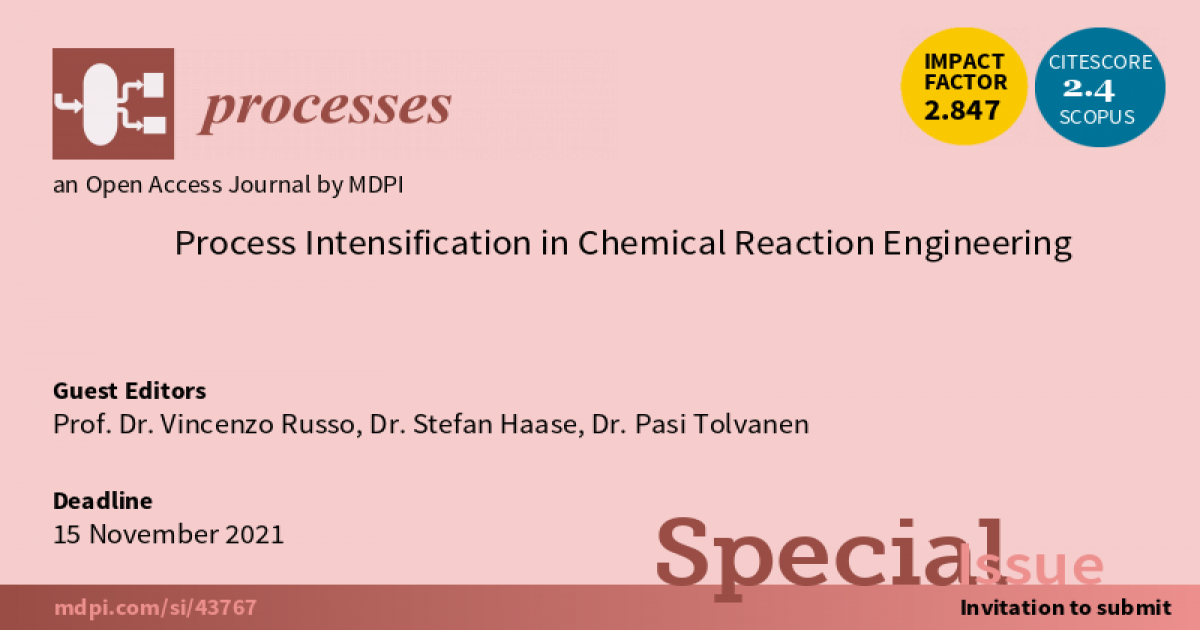- 2.8Impact Factor
- 5.5CiteScore
- 16 daysTime to First Decision
Process Intensification in Chemical Reaction Engineering
This special issue belongs to the section “Chemical Processes and Systems“.
Special Issue Information
Dear Colleagues,
Process Intensification (PI) is a modern trend in Chemical Reaction Engineering (CRE) science. The main concept is to develop sustainable and cost-effective chemical process systems, driven by the reduction of the equipment size, energy consumption, or waste generation. Several efforts were made, focusing on different kind of technologies:
- microreactors and micromixers
- static mixers
- alternative sources of energy: microwave and ultrasound
- two unit operations in one apparatus: reactive chromatopraphy/reactive distillation
- alternative fluids: supercritical fluids, ionic liquids, SILCA
- structured catalysts; foams, monoliths, 3D-printed structures
The development of Process Intensification requires the deep understanding of several aspects which comprise CRE, spreading from reactor modelling/design to the investigation of microfluidics, treating with rigour the physical and chemical phoenomena occurring in the reaction network.
This Special Issue on “Process Intensification in Chemical Reaction Engineering” aims to illustrate novel trends in CRE to demonstrate that with the right approach, it is possible to aim the PI of a chemical process.
Prof. Dr. Vincenzo RussoDr. Stefan Haase
Prof. Dr. Pasi Tolvanen
Guest Editors
Manuscript Submission Information
Manuscripts should be submitted online at www.mdpi.com by registering and logging in to this website. Once you are registered, click here to go to the submission form. Manuscripts can be submitted until the deadline. All submissions that pass pre-check are peer-reviewed. Accepted papers will be published continuously in the journal (as soon as accepted) and will be listed together on the special issue website. Research articles, review articles as well as short communications are invited. For planned papers, a title and short abstract (about 250 words) can be sent to the Editorial Office for assessment.
Submitted manuscripts should not have been published previously, nor be under consideration for publication elsewhere (except conference proceedings papers). All manuscripts are thoroughly refereed through a single-blind peer-review process. A guide for authors and other relevant information for submission of manuscripts is available on the Instructions for Authors page. Processes is an international peer-reviewed open access semimonthly journal published by MDPI.
Please visit the Instructions for Authors page before submitting a manuscript. The Article Processing Charge (APC) for publication in this open access journal is 2400 CHF (Swiss Francs). Submitted papers should be well formatted and use good English. Authors may use MDPI's English editing service prior to publication or during author revisions.
Keywords
- Process Intensification
- Chemical Reaction Engineering
- Microreactors, Microwaves
- Sonochemistry
- Reactive Chromatography
- Reactive Distillation
- Structured Reactors
- Static Mixers
- Microfluidics

Benefits of Publishing in a Special Issue
- Ease of navigation: Grouping papers by topic helps scholars navigate broad scope journals more efficiently.
- Greater discoverability: Special Issues support the reach and impact of scientific research. Articles in Special Issues are more discoverable and cited more frequently.
- Expansion of research network: Special Issues facilitate connections among authors, fostering scientific collaborations.
- External promotion: Articles in Special Issues are often promoted through the journal's social media, increasing their visibility.
- e-Book format: Special Issues with more than 10 articles can be published as dedicated e-books, ensuring wide and rapid dissemination.

